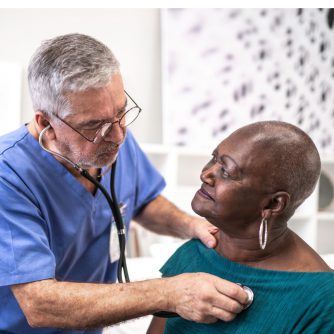Samaritan is a proud provider of Dementia Care and uniquely distinguished as a GUIDE provider by the Centers for Medicare and Medicaid (CMS). Click to learn more.
(856) 596-1600 available 24/7 Refer Now

By: Stephen Goldfine, MD, DABFP, CAQGM, DABHP – Chief Medical Officer, Samaritan
for publication in the Healthcare Leadership Network of the Delaware Valley newsletter
 With millions of Americans fallen ill and the death toll recently reaching more than 500,000, the COVID-19 pandemic has radically impacted our healthcare system and the way we deliver care. COVID-19 highlighted the need for improvement, innovation, evolution, and the essential role of palliative medicine and hospice care.
With millions of Americans fallen ill and the death toll recently reaching more than 500,000, the COVID-19 pandemic has radically impacted our healthcare system and the way we deliver care. COVID-19 highlighted the need for improvement, innovation, evolution, and the essential role of palliative medicine and hospice care.
Providers across all healthcare settings quickly learned to pivot and adapt to overcome a continuing barrage of seemingly insurmountable barriers to deliver essential care. Those unprecedented barriers included overcrowded hospitals, medication shortages, limited availability of personal protective equipment (PPE), staff shortages, and restrictions on access to patients.
Hospice and palliative care providers were no exception. While honoring the fundamental essentials of palliative care to relieve suffering and honor the patients’ goals of care, Samaritan quickly adapted to ensure the continuation of essential services for people with advanced illness throughout the pandemic.
During the COVID-19 pandemic, “uncertainty” has been a word often used to describe the chaos experienced in all facets of personal and professional life. Navigating in-person visitation during the COVID-19 pandemic has been immensely stressful for all involved, from upset friends and family members to overwhelmed staff and healthcare providers who had to balance the needs of patients and families while protecting workers.
Samaritan’s patient volume has increased since March 2020 with more hospice and palliative referrals. Our teams continued to adapt to safety protocols and restrictions in all settings, utilizing technology and creativity to help ensure access for our patients and all those who care about them. One of many examples included our staff meeting family members in hospital parking lots to discuss our recommendations and gain required consents.
In addition to in-person visits throughout the pandemic, Samaritan launched a telemedicine platform through which they could provide the full range of hospice and palliative care services. While most of our hospice patients remain in their own homes, others live in skilled-nursing or assisted-living communities with varying limitations and safety protocols, including weekly testing of our staff providing care in those settings.
While our palliative physicians and nurse practitioners continued to provide inpatient palliative consultations in our partner hospitals, telemedicine provided a way to consult with other patients at home or in senior living communities.
Many patients died alone after months or weeks of separation from their families, presenting another dimension of stress, anxiety, and grief. Our team saw many patients who had spent months in hospitals or long-term care communities with no visitors allowed. With added safety precautions, we were able to allow families to visit patients at our two inpatient hospice centers. Our Samaritan grief and spiritual support counselors, social workers, and music therapists responded with creative new virtual resources, remote counseling, and support groups.
The pandemic pushed conversations about prognosis and mortality to the forefront as the virus spread over the globe. More people were open to discussing their wishes for care, treatment, and quality of life. These conversations, already difficult, became even more challenging due to social distancing. Establishing trust through open dialogue opens the door to easing fears and educating patients about their prognosis. This is essential to supporting their goals of care, treatment decisions, and completing their advance directives or Practitioner’s Orders for Life-Sustaining Treatments (POLST) forms to guide the care team.
Providers asked questions like these to help patients identify their goals for care, treatment, and quality of life.
Responding to physical, emotional, and spiritual needs is essential to quality of life for patients with advanced illness and thus defines the core of hospice and palliative care services. Patients and their families benefit from the coordinated care of interdisciplinary teams that include physicians, nurses, social workers, spiritual support counselors, and certified home health aides. Managing pain and symptoms and relieving suffering is essential to helping patients live as fully as possible through the transition to the end of life.
From the beginning of the pandemic, providers witnessed rapid declines in the condition of their patients. This left little time to help patients and families to express their wishes and adequately prepare for the end-of-life.
With families and loved ones unable to see these patients, hospice and palliative care teams stepped up to fill new roles – advocating for the patient’s wishes and providing a lifeline for family members who could not be there in person.
Strictly following all health and safety precautions, the care team worked to ensure family visits could occur safely in person – recognizing the vital importance of those intimate interactions through the end of life.
At Samaritan, we are hopeful that the vaccine rollout will continue to be a step in a positive direction as we seek to define our “new normal” of life during a global pandemic. We will always be guided by the needs of our patients and those who care about them. We will continue to advocate locally and nationally for improving access to hospice and palliative care; especially important for the most vulnerable communities of color who have been disproportionately impacted by the pandemic and traditionally underutilized hospice and palliative care services. Thus, the essential role of hospice and palliative care in the healthcare continuum will remain as we navigate the pandemic in 2021 and beyond.